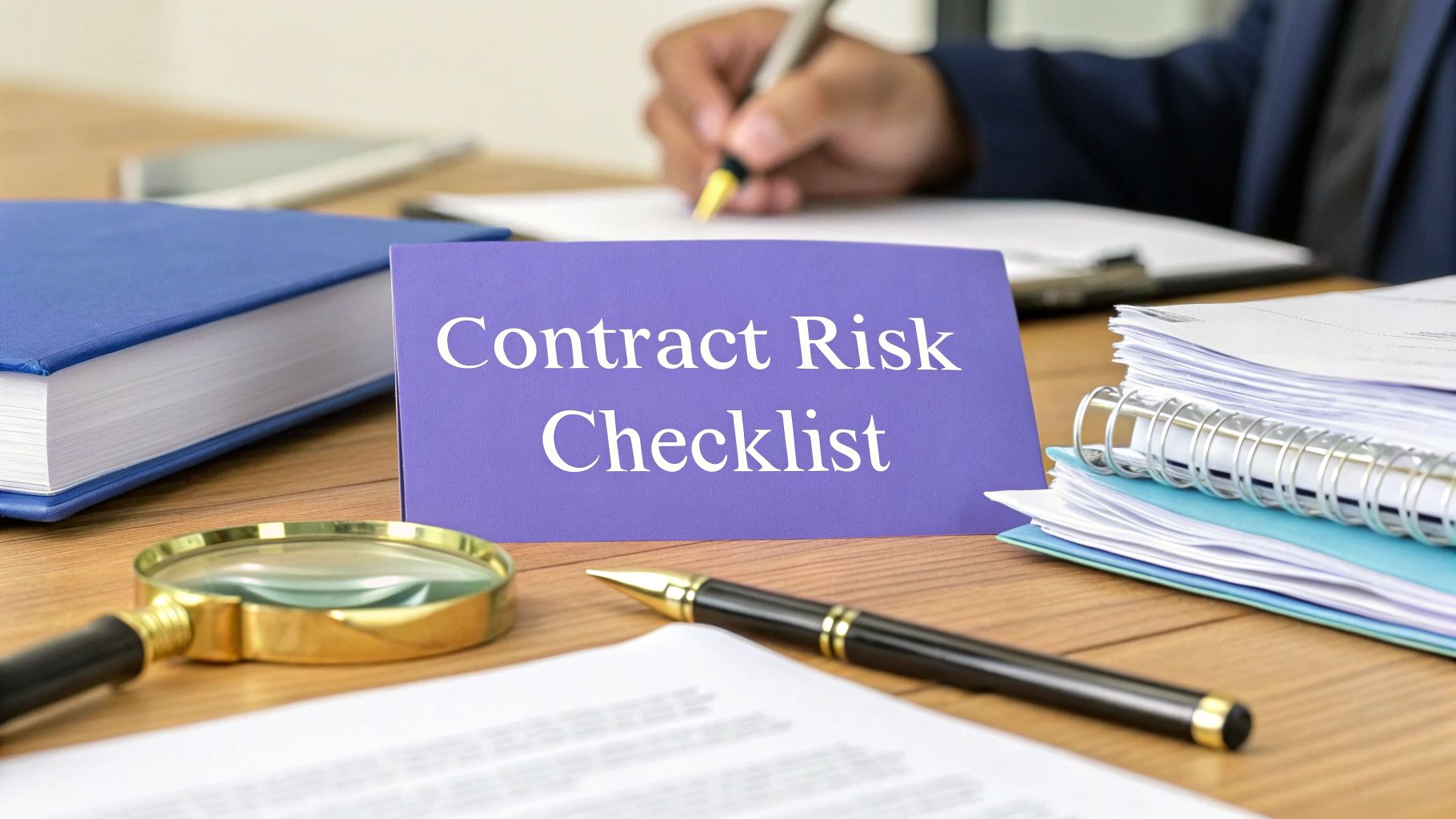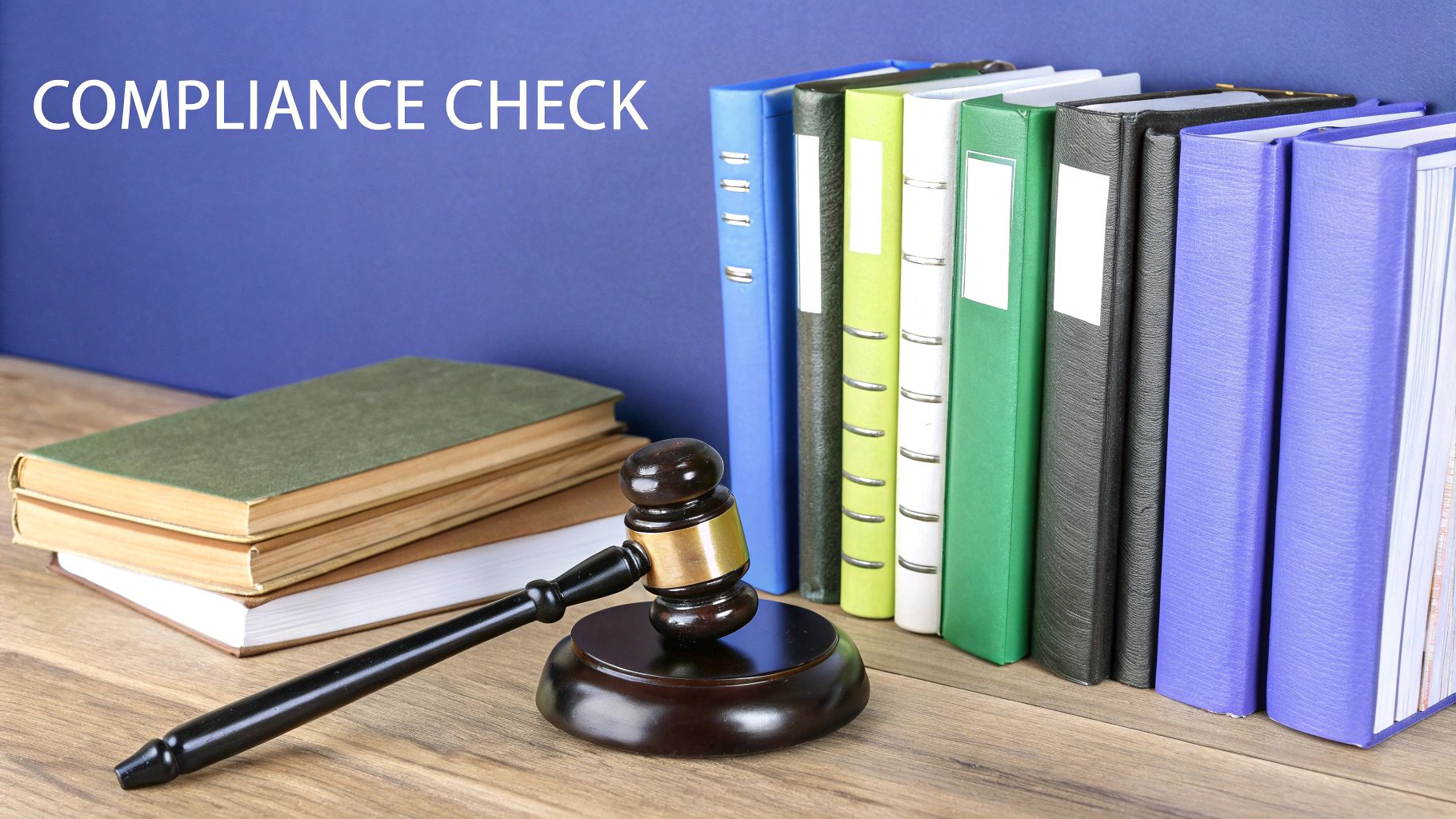
Navigating the Legal Landscape: Mastering Contract Risk in 2025
Contracts are fundamental to business, but also risky. A flawed contract can lead to financial loss, legal battles, and reputational harm. This contract risk assessment checklist helps you minimize those risks. This listicle details six essential areas to analyze in any contract, empowering you to make informed decisions and avoid potential problems. Learn how to assess counterparty due diligence, payment terms, termination clauses, compliance and regulatory risks, intellectual property rights, and force majeure provisions. Using this contract risk assessment checklist lets you confidently navigate contract complexities and protect your interests.
1. Counterparty Due Diligence
Counterparty due diligence is a critical component of any robust contract risk assessment checklist. It involves a thorough investigation and evaluation of the other party involved in a contract to assess their financial stability, reputation, compliance history, and overall capability to fulfill their contractual obligations. This preemptive evaluation helps identify potential risks associated with the party you're entering into an agreement with before finalizing the contract, allowing you to make informed decisions and avoid costly mistakes down the line. This process is essential for mitigating risks and ensuring a successful contract outcome.

This crucial step in a contract risk assessment checklist involves several key features: credit and financial health assessments, compliance and regulatory standing verification, litigation history review, operational capacity evaluation, corporate structure analysis, and reputation and reference checks. Learn more about Counterparty Due Diligence. A crucial step in counterparty due diligence is verifying the information provided. Services like Global Database Verification can be invaluable in ensuring the accuracy of the information you’re basing your decisions on.
Implementing counterparty due diligence offers several significant advantages. It prevents you from entering into agreements with financially unstable entities, reducing the risk of contract default or non-performance. It also identifies potential regulatory or legal issues early in the process, saving time and resources. Further, it establishes realistic expectations about the counterparty’s capabilities, facilitating smoother contract execution. For example, Goldman Sachs' comprehensive vendor risk management program includes extensive due diligence on financial health, cybersecurity, and operational capabilities, while Walmart's supplier assessment process evaluates financial stability, production capacity, and compliance history. These examples demonstrate how large corporations leverage counterparty due diligence to minimize risk and optimize their business relationships.
While the benefits are clear, counterparty due diligence also has some drawbacks. It can be a time-consuming and resource-intensive process, potentially delaying contract execution. Information availability can be limited, especially for private companies. Furthermore, it often requires specialized knowledge or third-party services.
When undertaking counterparty due diligence as part of your contract risk assessment checklist, consider these tips: adjust the depth of your due diligence to match the contract’s value and risk profile; use a combination of public records, financial reports, and direct inquiries to gather comprehensive information; implement a standardized scoring system to objectively evaluate counterparties; and document all findings for future reference and audit purposes. For long-term contracts, repeat assessments periodically to stay informed about any changes in the counterparty’s situation.
Counterparty due diligence is popularized by industry leaders like Ernst & Young’s Risk Advisory Services, which offer specialized expertise in this area. Tools such as Dun & Bradstreet business credit reports and Thomson Reuters CLEAR also provide valuable resources for enhanced due diligence. By incorporating counterparty due diligence into your contract risk assessment checklist, you are taking a proactive step towards minimizing potential risks and maximizing the likelihood of successful contract outcomes. This is a critical aspect of responsible business practice, particularly for small business owners, freelance professionals, and startups who may be particularly vulnerable to contract disputes and financial losses.
2. Payment Terms and Financial Risk Analysis
A crucial component of any contract risk assessment checklist is a thorough analysis of the payment terms and associated financial risks. This involves evaluating all financial aspects of the contract, including payment schedules, price adjustment mechanisms, currency risks, and potential financial penalties. This evaluation helps identify potential cash flow impacts, payment disputes, and financial loss exposures that could arise from the contractual arrangement. Ignoring this step can lead to significant financial distress down the line, making it essential for any sound contract review.

This analysis delves into several key features: payment timing and milestone evaluation, currency fluctuation risk assessment, price adjustment and escalation clause review, analysis of required financial security, fee structure and hidden cost identification, and assessment of financial default remedies. By thoroughly examining these aspects, businesses can gain a clearer understanding of the financial implications of the contract and proactively address potential issues.
Examples of Successful Implementation:
- Apple's supplier contracts: These contracts often include highly specific payment terms tied to stringent quality metrics and on-time delivery. This incentivizes suppliers to meet Apple's standards and protects Apple from financial losses due to subpar performance.
- Infrastructure projects using FIDIC contracts: These contracts incorporate sophisticated payment mechanisms with detailed risk allocation, addressing the complex financial realities of large-scale projects.
Tips for Effective Payment Terms and Financial Risk Analysis:
- Model cash flow impacts under different scenarios: Don't just consider the ideal scenario. Model potential delays, cost overruns, and other potential issues to understand the potential impact on your cash flow.
- Consider hedging strategies for currency or commodity price risks: If your contract involves international transactions or fluctuating commodity prices, explore hedging strategies to mitigate potential losses.
- Include clear remedies for late or missed payments: Clearly define the consequences of late or missed payments, including interest charges and potential termination clauses.
- Avoid open-ended financial commitments: Be wary of clauses that could lead to unexpected or uncontrolled costs. Specify clear limits and boundaries for financial obligations.
- Review accounting treatment implications before finalizing terms: Consult with your accounting team to understand how the contract terms will impact your financial reporting.
Pros:
- Improves cash flow predictability
- Identifies potential financial bottlenecks before they occur
- Reduces exposure to currency and inflation risks
- Ensures financial terms align with organizational capabilities
Cons:
- Complex financial modeling may be required
- Future economic conditions are inherently uncertain
- May create tension during negotiation when highlighting financial risks
Why this item deserves its place in the contract risk assessment checklist: Financial risks are often at the heart of contract disputes and business failures. A thorough analysis of payment terms and related financial aspects is essential for protecting your business interests and ensuring the long-term success of the contract. This element is crucial for everyone from small business owners to large corporations. This process is popularized by organizations such as the International Association for Contract & Commercial Management (IACCM), Project Management Institute (PMI), and Treasury Management Association, underscoring its importance in effective contract management.
3. Termination and Exit Strategy Assessment
A crucial component of any comprehensive contract risk assessment checklist is the termination and exit strategy assessment. This process involves a thorough evaluation of the contract's termination provisions, exit clauses, and transition arrangements. It ensures your organization can gracefully exit the agreement without incurring excessive penalties or experiencing significant business disruption. By proactively identifying potential lock-in risks, this assessment helps confirm the existence of appropriate mechanisms to end the relationship when necessary – whether due to breach of contract, changing business needs, or other unforeseen circumstances.

This item deserves a prominent place in any contract risk assessment checklist because it directly addresses the potential long-term consequences of entering into a contractual agreement. Overlooking these crucial exit strategies can lead to significant financial losses and operational challenges down the line. Features of a robust termination and exit strategy assessment include provisions for termination for convenience and for cause, clearly defined notice period requirements, transition assistance obligations, post-termination rights and obligations, and a clear methodology for wind-down cost allocation. For example, specifying data portability and return obligations protects your sensitive information upon contract termination.
Examples of successful implementations include Microsoft's cloud service agreements, which incorporate detailed data transition provisions upon termination, ensuring clients can retrieve their data seamlessly. Similarly, Accenture's professional services contracts often feature phased transition plans to facilitate knowledge transfer and minimize disruption when the contract ends. These examples showcase how established companies prioritize smooth transitions and mitigate potential risks associated with contract termination.
Pros:
- Provides strategic flexibility to adapt to evolving business needs and market conditions.
- Reduces dependency on specific vendors or partners, fostering a more competitive environment.
- Limits financial exposure when exiting problematic relationships, safeguarding your resources.
- Ensures business continuity during transitions, minimizing operational disruptions.
Cons:
- Negotiating strong exit provisions may increase initial contract costs.
- Can create tension during negotiations as parties seek to protect their respective interests.
- It is challenging to anticipate all potential exit scenarios and draft provisions that address every possibility.
Tips for effective termination and exit strategy assessment:
- Include detailed transition assistance requirements, specifying responsibilities and timelines.
- Clearly define data portability and return obligations to protect sensitive information.
- Establish objective criteria for termination for cause to avoid disputes.
- Consider graduated termination fees that decrease over time, incentivizing long-term commitment while providing flexibility.
- Include provisions for partial termination where appropriate, allowing for adjustments to the scope of the agreement.
- Thoroughly document your exit strategy before contract execution.
Learn more about Termination and Exit Strategy Assessment
This approach is essential for anyone entering into a contract, from small business owners to large enterprises. By understanding and implementing these strategies, you can effectively manage contract risk and protect your organization's interests. The concepts discussed here are often highlighted by organizations such as Gartner in their IT sourcing research, the International Association for Contract & Commercial Management (IACCM), and in Harvard Business Review articles on strategic contract management. By prioritizing termination and exit strategy assessment within your contract risk assessment checklist, you are proactively safeguarding your business from potential future complications and ensuring a smoother, more controlled exit process if and when required.
4. Compliance and Regulatory Risk Evaluation
A crucial component of any comprehensive contract risk assessment checklist is the compliance and regulatory risk evaluation. This process involves meticulously examining the contract to ensure its adherence to all applicable laws, regulations, and industry standards across every relevant jurisdiction. This evaluation pinpoints potential legal vulnerabilities, regulatory violations, and compliance obligations that must be addressed to mitigate the risk of penalties, litigation, or reputational harm. Ignoring this step can expose your business to significant financial and legal consequences. This is especially important for small business owners, freelancers, and startups who may have limited resources to handle legal disputes.

This evaluation encompasses several key features, including multi-jurisdictional legal compliance verification, industry-specific regulatory requirement review, data privacy and protection assessment (crucial in the age of GDPR and other data protection laws), environmental compliance evaluation, labor and employment law compliance checks, and export control and trade compliance reviews. For example, if your contract involves processing personal data of European Union citizens, ensuring GDPR compliance is non-negotiable.
This thorough approach brings numerous advantages. It prevents costly regulatory violations and penalties, reducing the risk of litigation and enforcement actions. It also protects your organization's reputation and ensures ethical business practices, which are increasingly important for consumers and investors alike. Real-world examples of this in action include Pfizer's supplier contracts mandating GDPR compliance with specific breach notification timeframes, and JP Morgan Chase's vendor agreements requiring adherence to anti-money laundering provisions. These large corporations understand the importance of proactive compliance, a lesson applicable to businesses of all sizes.
However, there are also challenges associated with compliance and regulatory risk evaluation. Regulatory landscapes are in constant flux, and cross-border compliance can be particularly complex and expensive. It often requires specialized legal expertise across multiple domains, which can be a significant investment, especially for smaller businesses.
To streamline the process and maximize its effectiveness, consider these actionable tips:
- Create jurisdiction-specific compliance checklists: This helps ensure no critical legal requirement is overlooked.
- Include right-to-audit provisions for compliance verification: This empowers you to confirm the other party's adherence to the agreed-upon standards.
- Incorporate regulatory change management provisions: This allows the contract to adapt to evolving legal requirements, providing flexibility and reducing future risks.
- Clearly define compliance responsibility allocation: This avoids ambiguity and ensures accountability.
- Consider third-party compliance certification requirements: This can add an extra layer of assurance, particularly in complex regulatory environments.
- Document compliance review process and findings: Maintaining a clear record of your due diligence is essential for demonstrating good faith and defending against potential claims.
Learn more about Compliance and Regulatory Risk Evaluation
Compliance and regulatory risk evaluation deserves a prominent place on any contract risk assessment checklist because it proactively addresses potential legal pitfalls. By identifying and mitigating these risks early in the contract lifecycle, businesses can avoid costly legal battles, protect their reputation, and ensure long-term success. This step is essential for everyone from individuals managing personal agreements to in-house legal teams at large enterprises seeking scalable and efficient contract management. This proactive approach is not just a best practice; it's a necessity in today's complex regulatory environment.
5. Intellectual Property and Data Rights Assessment
A crucial element of any comprehensive contract risk assessment checklist is a thorough Intellectual Property and Data Rights Assessment. This evaluation delves into all aspects of intellectual property (IP) and data ownership, usage, and protection stipulations within the contract. Neglecting this step can expose your business to significant risks related to IP rights, data breaches, confidentiality violations, and even the loss of your competitive edge. This is why it deserves a prominent place in your contract risk assessment checklist.
This assessment works by systematically reviewing the contract for provisions related to several key areas:
- IP Ownership and License Terms Review: Determine who owns the pre-existing IP (background IP) brought to the table and any newly created IP (foreground IP) resulting from the contract. The contract should clearly delineate ownership and grant specific licenses with defined usage limitations.
- Data Ownership and Usage Rights Clarification: Define who owns the data generated, collected, or used in connection with the contract. Specify permitted usage rights, including aggregation and anonymization. This is critical for compliance with data privacy regulations.
- Confidential Information Protection Provisions: Identify what information is considered confidential and the obligations of each party to protect it. Robust confidentiality provisions should include practical timeframes and clear enforcement mechanisms.
- Technology Transfer and Knowledge Sharing Terms: Outline the processes and limitations for transferring technology and sharing knowledge between the parties. This is especially important in collaborative projects or technology licensing agreements.
- Third-Party IP Infringement Indemnities: Ensure the contract includes provisions that protect your business from liability if the other party's IP infringes on the rights of a third party.
- Post-Termination IP and Data Rights Analysis: Clearly define what happens to IP and data ownership, access, and usage rights after the contract terminates. This prevents future disputes and ensures a smooth transition.
Examples of Successful Implementation:
- IBM's service contracts meticulously specify background IP versus foreground IP, providing clear ownership delineation to avoid future disputes.
- Netflix's content licensing agreements include detailed rights windows and territory restrictions, maximizing the value of their intellectual property and controlling distribution.
Actionable Tips:
- Clearly define background and foreground IP ownership from the outset.
- Include specific license grants with clear usage limitations, preventing unintended exploitation of your IP.
- Specify data usage, aggregation, and anonymization rights, especially in light of increasing data privacy regulations.
- Consider escrow arrangements for critical technology to protect your business in case the other party becomes insolvent.
- Include robust confidentiality provisions with practical timeframes and clear consequences for breaches.
- Ensure IP indemnities are backed by appropriate insurance to mitigate financial risks.
Pros:
- Protects valuable intellectual assets and proprietary information.
- Prevents inadvertent IP transfer or unauthorized use.
- Ensures appropriate rights to use deliverables and data.
- Reduces risk of infringement claims.
Cons:
- IP rights can be difficult to value accurately.
- Complex IP provisions may require specialized legal expertise.
- Negotiating favorable IP terms may increase contract costs.
When and Why to Use This Approach:
This approach is essential for any contract that involves the creation, use, or transfer of intellectual property or data. This includes, but is not limited to:
- Software development agreements
- Licensing agreements
- Joint ventures
- Research and development agreements
- Service agreements involving proprietary information
Popularized By: Organizations like the World Intellectual Property Organization (WIPO), the International Association for the Protection of Intellectual Property (AIPPI), and the International Trademark Association (INTA) have highlighted the importance of robust IP protection and management, influencing best practices in contract drafting and risk assessment.
By diligently performing an Intellectual Property and Data Rights Assessment, you safeguard your valuable intangible assets and minimize potential liabilities, ensuring a more secure and beneficial contractual relationship. This makes it a vital component of any effective contract risk assessment checklist.
6. Force Majeure and Business Continuity Risk Analysis
Force Majeure and Business Continuity Risk Analysis is a critical component of any comprehensive contract risk assessment checklist. This evaluation focuses on how a contract addresses unforeseeable events, disasters, and the parties' obligations to maintain business continuity. Including this analysis in your contract review process safeguards your business from unexpected disruptions and ensures that appropriate risk allocation and recovery mechanisms are in place for events beyond the normal control of either party. This is crucial for minimizing potential losses and maintaining operational stability in times of crisis.
How it Works:
This analysis involves a thorough review of contract provisions related to unforeseen circumstances. It assesses the scope and definition of the force majeure clause, examining whether it adequately covers a range of potential disruptions, from natural disasters and pandemics to political instability and supply chain breakdowns. The analysis also evaluates the contract's requirements for business continuity and disaster recovery, including provisions related to supply chain resilience, critical service recovery time objectives, and specific measures to mitigate geopolitical risks.
Features:
- Force majeure clause scope and definition review: Determining the breadth and specificity of covered events.
- Business continuity and disaster recovery requirements: Assessing obligations for maintaining operations during disruptions.
- Supply chain resilience provisions: Identifying backup plans and alternative sourcing strategies.
- Pandemic and health emergency provisions: Evaluating specific clauses addressing health crises.
- Geopolitical risk mitigation measures: Examining clauses addressing political instability or international conflicts.
- Critical service recovery time objectives: Defining acceptable downtimes for essential services.
Pros:
- Clarifies responsibility during extraordinary events: Avoids disputes about obligations when unforeseen events occur.
- Ensures business continuity during disruptions: Minimizes downtime and maintains operational stability.
- Reduces uncertainty about contract obligations during crises: Provides a clear framework for action during emergencies.
- Prevents opportunistic behavior during emergencies: Discourages parties from using force majeure inappropriately to escape obligations.
Cons:
- Difficult to anticipate all possible disruptive scenarios: No contract can perfectly foresee every potential disruption.
- Business continuity requirements may increase contract costs: Implementing robust continuity plans can be expensive.
- May create a false sense of security if not properly implemented: A poorly drafted or unenforced force majeure clause offers little protection.
Examples of Successful Implementation:
- Pandemic-specific clauses: Following the COVID-19 pandemic, many contracts now include specific clauses outlining trigger events (e.g., government-mandated lockdowns) and consequences (e.g., adjusted delivery timelines) related to pandemics.
- Marriott International's vendor agreements: Marriott requires its vendors to demonstrate specific business continuity capabilities and participate in regular testing to ensure they can maintain services during disruptions.
Actionable Tips:
- Define force majeure events specifically rather than generically: Avoid vague terms like "acts of God." List specific events (e.g., earthquakes, floods, specific named pandemics).
- Include notification and mitigation obligations: Specify how and when parties must notify each other of a force majeure event and what steps they must take to mitigate its impact.
- Specify maximum duration before termination rights activate: Define how long a force majeure event can continue before either party can terminate the contract.
- Require regular testing of business continuity plans: Ensure that plans are up-to-date and effective.
- Consider geographic diversification requirements for critical supplies: Reduce reliance on single-source suppliers in a single location.
- Document backup arrangements and alternative sources: Identify alternative suppliers or resources in case primary sources are unavailable.
Why this Item Deserves its Place in the Checklist:
In today's interconnected and volatile world, unforeseen events can significantly impact businesses. A robust force majeure and business continuity risk analysis ensures that contracts address these potential disruptions proactively, protecting all parties involved. This is particularly important for small business owners, freelancers, and startups who may be especially vulnerable to disruptions. By incorporating this analysis into your contract risk assessment checklist, you demonstrate a commitment to preparedness and risk management, fostering trust and stability in your business relationships.
Popularized By: Business Continuity Institute (BCI), Disaster Recovery Institute International (DRII), International Chamber of Commerce (ICC) force majeure clause model.
Contract Risk Assessment Checklist Comparison
| Checklist Item | Implementation Complexity 🔄 | Resource Requirements 🔄 | Expected Outcomes 📊 | Ideal Use Cases 💡 | Key Advantages ⭐ |
|---|---|---|---|---|---|
| Counterparty Due Diligence | Moderate to High - requires specialized knowledge | High - financial experts, third-party services | Risk identification, financial stability verification | High-value contracts, new or unknown partners | Reduces counterparty risk, prevents defaults |
| Payment Terms and Financial Risk Analysis | High - involves complex financial modeling | Moderate to High - finance and treasury involvement | Improved cash flow predictability, risk exposure reduction | Contracts with significant financial impact | Enhances financial control and risk mitigation |
| Termination and Exit Strategy Assessment | Moderate - requires legal and strategic input | Moderate - legal and operational teams | Flexibility in exit, reduced lock-in and disruption | Long-term agreements, vendor/partner engagements | Limits financial exposure, ensures smooth transitions |
| Compliance and Regulatory Risk Evaluation | High - multi-jurisdictional, legal expertise needed | High - specialized legal resources | Avoids penalties, ensures regulatory adherence | Highly regulated industries, cross-border contracts | Prevents legal violations, protects reputation |
| Intellectual Property and Data Rights Assessment | Moderate to High - legal and technical expertise needed | Moderate to High - IP/legal specialists | Protection of IP assets and data rights | Technology, content licensing, innovation contracts | Safeguards proprietary info, reduces infringement risk |
| Force Majeure and Business Continuity Risk Analysis | Moderate - legal and operational planning required | Moderate - risk management and legal inputs | Business continuity during crises, clear emergency roles | Contracts vulnerable to external disruptions | Clarifies responsibilities, ensures crisis preparedness |
Proactive Contract Management: Shielding Your Business from Risk
Implementing a robust contract risk assessment checklist is paramount for safeguarding your interests, whether you're a small business owner, a freelance professional, or part of a large enterprise. This article has outlined six crucial areas of focus within your contract risk assessment checklist: counterparty due diligence, payment terms analysis, termination strategy assessment, compliance and regulatory risk evaluation, intellectual property review, and force majeure planning. Mastering these areas allows you to proactively identify potential legal and financial pitfalls, turning contracts from potential liabilities into strategic assets. By understanding the nuances of each point in the checklist, you can negotiate more effectively, build stronger relationships with partners, and ultimately foster sustainable business growth. Remember, a well-structured contract isn't merely a formality; it's a roadmap for success, protecting your business and paving the way for a more secure future.
Taking control of your contract review process doesn't have to be overwhelming. Streamline your contract risk assessment checklist and ensure no critical risk goes unnoticed with Legal Document Simplifier. Visit Legal Document Simplifier today and discover how automated summaries and alerts can empower you to manage contracts with confidence and efficiency.